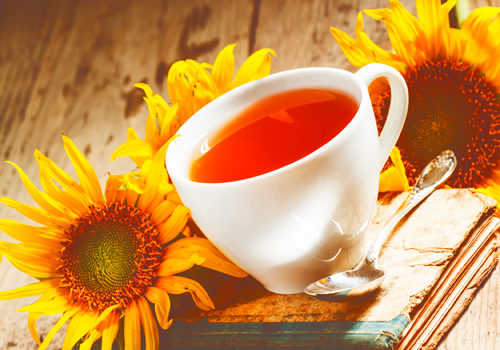
When we think of modern medicine, the first thoughts that come to mind are pills and maybe the liquid form that you are only supposed to take a teaspoon of. But what if there have been different forms of medicine around us for centuries that you’re missing out on?
Medicinal Teas
Whether it is a dandelion root or a peppermint plant, many types of commonplace plants are used to make medicinal teas.
Now, just to clarify, these teas are not like those canned sugary iced teas from the convenience store or even a black tea served up at your local coffee shop. These teas are often made from the Camellia sinensis plant and contain caffeine and theanine, which affect the brain and heighten mental alertness (1). Other teas strictly sold to be enjoyed as a beverage include the more common green, black, white, oolong and pu-erh teas, to name a few.
While some research on these teas suggests they offer health benefits, like green teas, medicinal teas are different. Their expressed purpose is to support health first and foremost, and often are sold as herbal supplements.
Medicinal teas may come from herbs, fruits, seeds or roots, and are intended to be steeped in hot water (1). They can be created using a variety of different plants and roots, all of which are said to aid the human body in a different way. Space doesn’t allow for a full rundown of all the medicinal teas in your local store, but here are some highlights:
• Dandelion herb and root (Taraxacum officinale). While images of those annoying yellow weeds growing in your yard may come to mind, there’s a lot to respect about dandelion. Tea infused with dandelion root is said to help detoxify the body and wash away fat during the digestive process (2). Some experts believe dandelion supports liver health and proper kidney function.
• Licorice (Glycyrrhiza glabra). This is not the candy version of licorice, but the medicinal tea version, which is commonly used to aid in digestive and respiratory health (2). Some say these effects are attributed to the herb’s phytochemicals (like glycyrrhizic acid) that are said to decrease swelling and coughing (3), but nothing has been scientifically proven to treat disease.
• Ginger (Zingiber officinale). While most of us have tried ginger ale, ginger tea has many health properties you won’t find with soda. It is used for “its ability to tame motion sickness, ease unhappy stomachs and soothe digestive upset (2).”
• Chamomile (Matricaria recutita) is another medicinal tea often used as a digestive aid.
• Peppermint (Mentha × piperita). Peppermint offers menthol, which provides a cooling sensation that aids in “soothing irritated stomachs to alleviating digestive discomfort (2).”
• Echinacea (Echinacea purpurea and Echinacea angustifolia). This tea is said to contain alkylamides, which support immune health (2).
Again, these supplements are intended to support good health, and shouldn’t be considered to be a treatment for any illness. Talk with your healthcare provider before adding a new medicinal tea to your health regimen.
Kombucha
Increasing in popularity among health-oriented shoppers, kombucha is a “fermented tea made by adding a culture of bacteria and yeast to a solution of tea, sugar and sometimes fruit juices and other flavoring (4).” It is also known as the mushroom tea, even though it is not made from mushrooms, but the “bacteria and yeast that grow on top of the beverage result in a blob that resembles a mushroom (5).”
According to the Memorial Sloan Kettering Cancer Center, this medicinal beverage has been studied as a treatment for the hardening of arteries, diabetes, AIDS and lower blood pressure, but it cannot be considered a cure for diseases (5). Additionally, studies have been done on animals that show kombucha has antioxidant effects and that it demonstrates “immune stimulating activity (5).” More research is needed, however, before kombucha can be used for these purposes.
This drink can be prepared in two different ways, each of which is said to contain different health benefits. Drinking kombucha in its raw, or unpasteurized, form is believed to be “rich in probiotics, good gut bacteria that have been linked to immunity and overall health (4).” While consuming it this way does have its benefits, it also comes with the possibility of health risks. Since this version of the beverage is unpasteurized, there is a chance of the product being produced in unsanitary conditions, meaning that consumers run the risk of “stomach upset, acidosis, allergic reactions to the molds that can develop during fermentation, and toxicity from heavy metals from home-brewing in ceramic pots (4).”
Additionally, Kombucha may be fermented, making the finished product “highly acidic, contains sugar, B vitamins and antioxidants, as well as some alcohol that results from the fermentation process (4).” WF
References
1. J. Edgar, “Types of Teas and Their Health Benefits,” www.webmd.com/diet/tea-types-and-their-health-benefits, accessed June 26, 2015.
2. Traditional Medicinals, www.traditionalmedicinals.com, accessed 6/26/15.
3. “Licorice,” www.webmd.com/vitamins-supplements/ingredientmono-881-licorice.aspx?activeingredientid=881&activeingredientname=licorice, accessed June 26, 2015.
4. E. Krieger, “Kombucha: Is it Really Good for You?” www.washingtonpost.com/lifestyle/wellness/2014/10/28/7ba5f68a-5ad6-11e4-8264-deed989ae9a2_story.html, accessed June 26, 2015.
5. Memorial Sloan Kettering Cancer Center, “Kombucha,” www.mskcc.org/cancer-care/integrative-medicine/herbs/Kombucha, accessed June 26, 2015.
Published in WholeFoods Magazine, August 2015, (online 7/16/2015)










